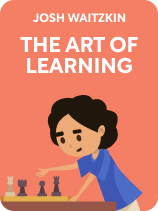

This article is an excerpt from the Shortform book guide to "The Art of Learning" by Josh Waitzkin. Shortform has the world's best summaries and analyses of books you should be reading.
Like this article? Sign up for a free trial here .
How do role models influence child development? How can you help your child discover their natural talents and develop their ability to persevere in spite of difficulties?
Adult role models shape children’s mindsets. One of the biggest influences is the feedback a child receives after attempting a difficult task. Coaching style is also important: it should be guiding (as opposed to controlling) to let the child discover their natural inclinations.
Here’s how feedback influences the child mindset, and how different coaching styles either support or hinder the learning process.
Parents and Coaches Determine a Child’s Mindset
Masterful coaching is crucial to success. Ideally, a good mentor should teach their students to love learning and guide them as they develop their unique abilities.
Waitzkin explains that kids learn how to think and feel from role models such as teachers, parents, and coaches. A child’s mindset—whether it’s a growth mindset or a fixed mindset—depends on how they’re raised. Specifically, it depends on the feedback.
Feedback that emphasizes the process helps children develop a growth mindset. As discussed earlier, having a growth mindset means that you attribute success to effort. Children with this mindset believe that they can develop their abilities, one step at a time.
Feedback such as, “Great job studying for that test, your hard work really paid off!” encourages the child to value effort.
(Shortform note: Critics of the push for growth mindset note that most growth mindset studies use the priming effect—prompting a particular state of mind with a phrase like “wow, you sure worked hard at that!”—and that this defies consistent replication. One study found that college students primed with a mindset message performed no better than the control group; another study found that growth mindset interventions are only effective if they occur in an environment that supports and encourages growth.)
Feedback that emphasizes innate talent reinforces a fixed mindset.t communicates that success depends on your inborn abilities, rather than those that you develop. Children with a fixed mindset don’t believe that they can develop their skills and tend to falter when faced with obstacles.
Feedback such as, “Wow, you’re so smart!” or, “Huh, guess math just isn’t for you,” encourages the child to think of skill in a black-and-white way: You either have it, or you don’t.
(Shortform note: Critics maintain that even if we assume growth mindset theory to be 100% true, it doesn’t disprove the importance of innate talent. In short, they argue that while believing in growth is beneficial, it doesn’t change the fact that we all start from different places. So while Person A might work twice as hard as Person B, B could have so much natural talent to begin with that A will likely never catch up. In other words, the only thing Dweck’s theory proves is that a belief in hard work tends to be helpful relative to your natural talent.)
Waitzkin says that parents and coaches have a responsibility to intentionally shape children’s mindsets. In his view, a growth mindset is far more healthy and enables kids to become resilient lifelong learners.
It’s possible to change mindsets, he claims—if you have a fixed mindset, you aren’t out of luck. Waitzkin cites a study that demonstrated how giving process-oriented versus results-oriented instructions can temporarily influence children’s mindsets. In the study, the kids primed with process-oriented instructions outperformed the results-oriented group.
(Shortform note: Whether growth mindset-based interventions actually work is up for debate. Educational researcher Carl Hendrick argues that many schools have misunderstood growth mindset as feel-good motivational fluff, and attempt to push a shallow, simplistic version of it on their students. Growth mindset has been subject to plenty of criticism over the years, and Dweck welcomes the dialogue, often acknowledging when her theory gets misinterpreted. Further, Waitzkin doesn’t offer evidence to show that these interventions last—they may simply demonstrate the priming effect: Giving students growth-focused feedback prompts them to temporarily change their mindsets.)
The 2 Types of Coaches
Coaches, Waitzkin says, can have a huge impact on a child’s learning process. As guides and teachers, coaches influence not just what a child learns, but how they learn.
Waitzkin discusses two types of coaches: Those who control and mold, and those who guide and nurture. In his view, the controlling type tends to squash a young learner’s natural inclinations. In contrast, the nurturing type brings out a child’s unique creativity.
(Shortform note: A parallel to Waitzkin’s coaching styles is the difference between schools with a prescribed, one-size-fits-all curriculum, and Montessori schools, which facilitate individualized, student-guided learning. Below, we’ll compare these schooling styles to Waitzkin’s perspective on coaching.)
Coaching Style #1: Break down and remold. A coach of this style has a rigid perspective on the skill. They often espouse the conventional wisdom of the skill, claiming to have the “correct” knowledge of dos and don’ts. They put all their students through one mold in an attempt to systematically produce skillful competitors.
On the positive side, these coaches put their students through rigorous training that instills a strong work ethic and a solid understanding of the skill. The downside is that they tend to dismiss a student’s personal style. This coach prefers his established method, which won’t resonate with some students. Everyone has their own style, Waitzkin says, and a coach who doesn’t recognize this risks squashing his student’s greatest assets.
Waitzkin describes how in his teenage years, a new chess coach trained him in a style that didn’t speak to him. Because he was forced to do this, he lost his spark and grew away from chess.
(Shortform note: Waitzkin’s perspective on rigid coaching dovetails with the belief of educator Sir Ken Robinson, who argued that modern schools had overly systematized the learning process. By applying the same curriculum to every student, schools “kill” students’ unique creativity. Both this type of schooling and coaching homogenize their student’s ways of thinking, feeling, and acting, and neglect each individual’s personal style. This hampers intrinsic motivation, which is when you engage in an activity because it’s naturally rewarding to you.)
Coaching Style #2: Understand and nurture. A coach of this style views the skill with an open mind. They act as a guide for their student and, Waitzkin says, nurture the student’s creative inclinations. With this support, the student can develop their own personal style while still gaining solid technical instruction.
Waitzkin describes his first coach, Bruce Pandolfini, who mentored him when he started playing chess at age 6. Pandolfini first got to know him as a human, establishing a healthy relationship that enabled more personalized instruction. Instead of fitting him through a mold, Pandolfini tailored his lessons to Waitzkin’s specific needs.
(Shortform note: Nurturing coaches evoke the approach of Montessori schools, where students direct their own learning trajectory based on what interests them most. Students select their own activities during “free choice” work periods, while teachers act as guides, giving individual and small-group lessons as needed. Montessori holds that this provides space for children to learn at their own pace, and helps them develop their own areas of interest. In contrast to conventional education, this approach fosters intrinsic motivation.)

———End of Preview———
Like what you just read? Read the rest of the world's best book summary and analysis of Josh Waitzkin's "The Art of Learning" at Shortform .
Here's what you'll find in our full The Art of Learning summary :
- Life advice from chess prodigy and tai chi World Champion Josh Waitzkin
- Detailed looks at the psychological and technical sides of skill-building
- How to build any skill from the bottom-up






